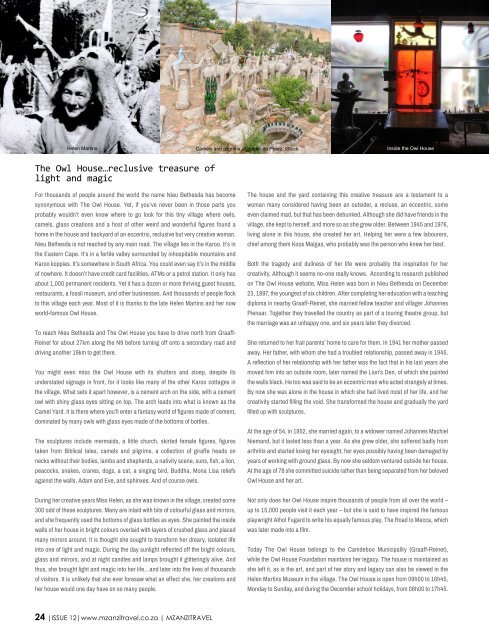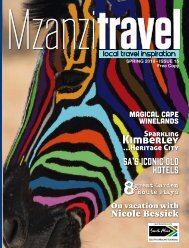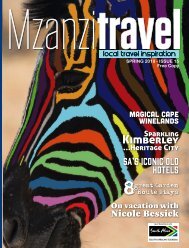MZANZITRAVEL ISSUE 12
Local Travel Inspiration
Local Travel Inspiration
- No tags were found...
You also want an ePaper? Increase the reach of your titles
YUMPU automatically turns print PDFs into web optimized ePapers that Google loves.
Discover<br />
Helen Martins Camels and pilgrims - Grobler du Preez, iStock Inside the Owl House<br />
The Owl House…reclusive treasure of<br />
light and magic<br />
For thousands of people around the world the name Nieu Bethesda has become<br />
synonymous with The Owl House. Yet, if you’ve never been in those parts you<br />
probably wouldn’t even know where to go look for this tiny village where owls,<br />
camels, glass creations and a host of other weird and wonderful figures found a<br />
home in the house and backyard of an eccentric, reclusive but very creative woman.<br />
Nieu Bethesda is not reached by any main road. The village lies in the Karoo. It’s in<br />
the Eastern Cape. It’s in a fertile valley surrounded by inhospitable mountains and<br />
Karoo koppies. It’s somewhere in South Africa. You could even say it’s in the middle<br />
of nowhere. It doesn’t have credit card facilities, ATMs or a petrol station. It only has<br />
about 1,000 permanent residents. Yet it has a dozen or more thriving guest houses,<br />
restaurants, a fossil museum, and other businesses. And thousands of people flock<br />
to this village each year. Most of it is thanks to the late Helen Martins and her now<br />
world-famous Owl House.<br />
To reach Nieu Bethesda and The Owl House you have to drive north from Graaff-<br />
Reinet for about 27km along the N9 before turning off onto a secondary road and<br />
driving another 19km to get there.<br />
You might even miss the Owl House with its shutters and stoep, despite its<br />
understated signage in front, for it looks like many of the other Karoo cottages in<br />
the village. What sets it apart however, is a cement arch on the side, with a cement<br />
owl with shiny glass eyes sitting on top. The arch leads into what is known as the<br />
Camel Yard. It is there where you’ll enter a fantasy world of figures made of cement,<br />
dominated by many owls with glass eyes made of the bottoms of bottles.<br />
The sculptures include mermaids, a little church, skirted female figures, figures<br />
taken from Biblical tales, camels and pilgrims, a collection of giraffe heads on<br />
necks without their bodies, lambs and shepherds, a nativity scene, suns, fish, a lion,<br />
peacocks, snakes, cranes, dogs, a cat, a singing bird, Buddha, Mona Lisa reliefs<br />
against the walls, Adam and Eve, and sphinxes. And of course owls.<br />
The house and the yard containing this creative treasure are a testament to a<br />
woman many considered having been an outsider, a recluse, an eccentric, some<br />
even claimed mad, but that has been debunked. Although she did have friends in the<br />
village, she kept to herself, and more so as she grew older. Between 1945 and 1976,<br />
living alone in this house, she created her art. Helping her were a few labourers,<br />
chief among them Koos Malgas, who probably was the person who knew her best.<br />
Both the tragedy and dullness of her life were probably the inspiration for her<br />
creativity. Although it seems no-one really knows. According to research published<br />
on The Owl House website, Miss Helen was born in Nieu Bethesda on December<br />
23, 1897, the youngest of six children. After completing her education with a teaching<br />
diploma in nearby Graaff-Reinet, she married fellow teacher and villager Johannes<br />
Pienaar. Together they travelled the country as part of a touring theatre group, but<br />
the marriage was an unhappy one, and six years later they divorced.<br />
She returned to her frail parents’ home to care for them. In 1941 her mother passed<br />
away. Her father, with whom she had a troubled relationship, passed away in 1945.<br />
A reflection of her relationship with her father was the fact that in his last years she<br />
moved him into an outside room, later named the Lion’s Den, of which she painted<br />
the walls black. He too was said to be an eccentric man who acted strangely at times.<br />
By now she was alone in the house in which she had lived most of her life, and her<br />
creativity started filling the void. She transformed the house and gradually the yard<br />
filled up with sculptures.<br />
At the age of 54, in 1952, she married again, to a widower named Johannes Machiel<br />
Niemand, but it lasted less than a year. As she grew older, she suffered badly from<br />
arthritis and started losing her eyesight, her eyes possibly having been damaged by<br />
years of working with ground glass. By now she seldom ventured outside her house.<br />
At the age of 78 she committed suicide rather than being separated from her beloved<br />
Owl House and her art.<br />
During her creative years Miss Helen, as she was known in the village, created some<br />
300 odd of these sculptures. Many are inlaid with bits of colourful glass and mirrors,<br />
and she frequently used the bottoms of glass bottles as eyes. She painted the inside<br />
walls of her house in bright colours overlaid with layers of crushed glass and placed<br />
many mirrors around. It is thought she sought to transform her dreary, isolated life<br />
into one of light and magic. During the day sunlight reflected off the bright colours,<br />
glass and mirrors, and at night candles and lamps brought it glitteringly alive. And<br />
thus, she brought light and magic into her life…and later into the lives of thousands<br />
of visitors. It is unlikely that she ever foresaw what an effect she, her creations and<br />
her house would one day have on so many people.<br />
Not only does her Owl House inspire thousands of people from all over the world –<br />
up to 15,000 people visit it each year – but she is said to have inspired the famous<br />
playwright Athol Fugard to write his equally famous play, The Road to Mecca, which<br />
was later made into a film.<br />
Today The Owl House belongs to the Camdeboo Municipality (Graaff-Reinet),<br />
while the Owl House Foundation maintains her legacy. The house is maintained as<br />
she left it, as is the art, and part of her story and legacy can also be viewed in the<br />
Helen Martins Museum in the village. The Owl House is open from 09h00 to 16h45,<br />
Monday to Sunday, and during the December school holidays, from 08h00 to 17h45.<br />
24 |<strong>ISSUE</strong> <strong>12</strong>|www.mzanzitravel.co.za | <strong>MZANZITRAVEL</strong>
















